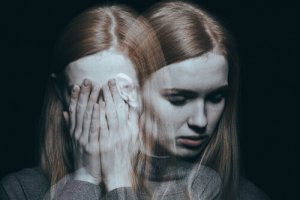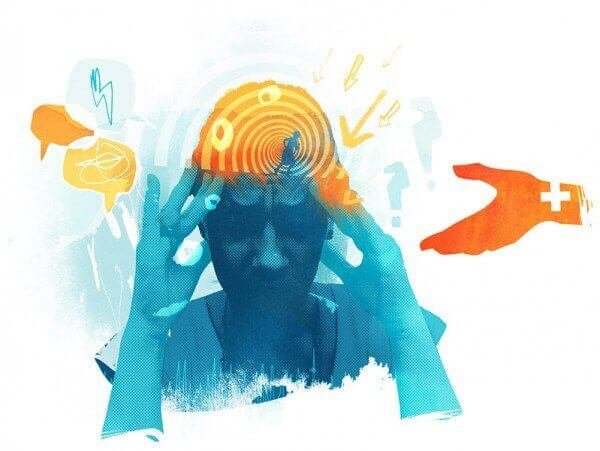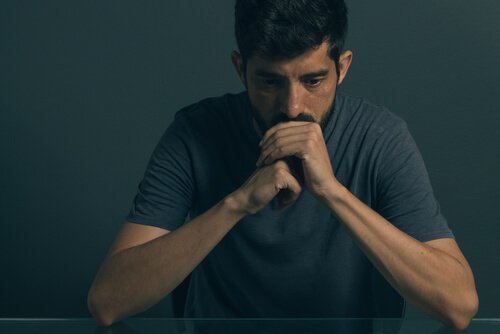Schizoaffective Disorder: History, Symptoms, and Treatment

The main characteristic of schizoaffective disorder is that there are symptoms of schizophrenia alongside symptoms of a mood disorder (for example, auditory hallucinations, confused language, and episodes of major depression). But the diagnostic guidelines for this disorder have changed over time. Most of the time the changes happen because of changes to the diagnostic guidelines for schizophrenia and mood disorders.
But even with all those changes to the guidelines, it’s still the best diagnosis for patients who might get the wrong kind of clinical treatment if their doctor saw it as just schizophrenia or just a mood disorder.
The history of schizoaffective disorder
George H. Kirby in 1913 and August Hoch in 1921 both described patients with symptoms mixed between schizophrenia and affective (or mood) disorders. Because neither patient kept on getting worse like they would with “dementia praecox,” Kirby and Hoch put them in the group of manic-depressive psychoses that Emil Kraepelin came up with.
In 1933, Jacob Kasanin coined the term “schizoaffective disorder” to refer to a disorder with symptoms of schizophrenia and symptoms of a mood disorder. He also noticed that usually the people with this disorder would very suddenly start to have symptoms, mostly as teenagers.
But these people could usually function well in their lives, and a lot of the time there was a specific stress factor that came right before their symptoms. And they usually had mood disorders in their family history.
Around 1970, two things brought about a shift in the way people looked at schizoaffective disorder. This lead them to stop seeing it as a form of schizophrenia and started to see it as a mood disorder. The first thing that changed their mind was that lithium was just as effective for people with bipolar as it was for some people with this disorder.
And the second thing was a joint study done in the US and UK that showed that only reason their was a difference in the number of patients labeled as schizophrenic in the US and UK was that there was a bias. Basically doctors in the US put more weight on whether there were psychotic symptoms when they were diagnosing schizophrenia.

How do you diagnose schizoaffective disorder?
Like we said, the concept of schizoaffective disorder includes diagnostic aspects of both shizophrenia and mood disoders. So that means the way the guidelines for this disorder have evolved mirrors the way the other two disorders we’ve looked at have evolved too.
The main thing someone has to show in this disorder is that they have to have experienced a major depressive episode or a manic one (they’re “full” of energy, don’t sleep much, make huge plans, waste a lot of money, etc.) at the same time as they have some symptoms of the active stages of schizophrenia (delusions, hallucinations, etc.).
The symptoms of their mood disorder also have to show up as a major part of the active or residual stage of their psychotic episodes. And the DSM (the Diagnostic and Statistical Manual of Mental Disorders) also allows you to decide whether a schizoaffective disorder is bipolar or depressive.
You classify a patient as the bipolar kind if the episode they have is mixed manic (with major depressive episodes or without them). But in any other situation, you classify the patient as someone with the depressive kind of schizoaffective disorder.
Symptosm a person has to show to be diagnosed with schizoaffective disorder
According to the DSM-IV (the Diagnostic and Statistical Manual of Mental Disorders IV), these are the symptoms a person has to show to be diagnosed with this disorder:
A. A consistent period of illness where at some point they have a major depressive, manic, or mixed episode. At the same time they also have to show symptoms of Criteria A for schizophrenia.
B. During the same period of illness they have to have had delusional ideas or hallucinations for at least 2 weeks without strong affective symptoms.
C. The symptoms that line up with the criteria for mood shift last for most of the time that the active and residual stages of the clinical illness are there.
How does schizoaffective disorder show up?
The signs and symptoms of this disorder are the same as schizophrenia, manic episodes, and depressive disorders. But the symptoms of schizophrenia or a mood disorder can show up at the same time or not.
It can progress in different ways. So there might be cycles where the person gets better and then worse with their symptoms before they take a clear downturn. A lot of researchers and doctors have wondered about the psychotic symptoms that don’t line up with mood. What that would mean is that the psychotic content (hallucinations or delusions) don’t match the patient’s mood.
In general, when these kinds of symptoms show up in a mood disorder it usually means the person has been diagnosed wrong. This might also be true for people with schizoaffective disorder, but we still don’t have enough information to be sure.

Symptoms of schizoaffective disorder
Like we said before, the symptoms of this disorder are the same as depression, mania, and schizophrenia:
Symptoms of depression
- Weight gain or weight loss.
- Poor appetite.
- Lack of energy.
- Loss of interest in enjoyable activities.
- Feeling hopeless or worthless.
- Guilt.
- Sleeping too little or too much.
- An inability to think or concentrate.
- Thoughts about death or suicide.
Symptoms of mania
- Little need to sleep.
- Agitation.
- Inflated self-esteem.
- Getting easily distracted.
- Increase in social, work, or sexual activity.
- Dangerous or self-destructive behavior.
- Quick thoughts.
- Speaking quickly.
Symptoms of schizophrenia
- Hallucinations.
- Delusions.
- Disordered thoughts.
- Strange or unusual behavior.
- Slow movement or no movement.
- Lack of motivation.
- Speech problems.
Does substance abuse play a part in causing schizoaffective disorder?
It’s hard to prove a clear relationship between taking drugs and developing psychotic disorders. But there is evidence specifically linked to using marijuana. The more cannabis a person consumes, the more likely it is they’ll develop a psychotic disorder. The risk factors are also higher if they consume it as a teenager.
A study done at Yale University in 2009 found that cannabinoides increase the symptoms of an established psychotic disorder and can lead to relapses. The two parts of cannabis that cause these effects are tetrahydrocannabinol (THC) and cannabidiol (CBD).
On top of that about half of all people with schizoaffective disorders use drugs or alcohol excessively. There’s also evidence that alcohol abuse can lead to a person developing a psychotic disorder.
Taking amphetamines and cocaine can also lead to psychotic episodes. Lastly, even though it’s not a cause of the disorder, studies say that people with schizoaffective disorder consume more nicotine than the general public.

How do you treat schizoaffective disorder?
The main ways to treat this disorder are hospitalization, medication, and psychosocial interventions. The basic principles they outline for treating these disorders with medication say that you should use the same rules as you do with antidepressant and antimanic drugs. You should only use antipsychotics if the patient needs some short term relief.
If the treatments for improving their mood don’t help control their symptoms, that would also be a reason to use antipsychotics. Some examples of these are haloperidol and risperidone.
The things we use to treat people with the bipolar kind of schizoaffective disorder are lithium, carbamazepine, valproate, or some combination of those. People with the depressive kind of schizoaffective disorder should get antidepressants and electroconvulsive therapy. You should always do that so that you can see if they respond to antidepression treatments.
As we’e seen, this is a complicated disorder. And that’s true both when it comes to defining it and treating it. But the most important thing you have to be clear about is that the symptoms of this disorder are the same as schizophrenia, manic episodes, and depressive disorders. And that’s exactly what makes it so complicated.
Bibliography:
Harold I. Kaplan, Benjamin J. Sadock. Kaplan and Sadock’s Synopsis of Psychiatry. Williams & Wilkins, Philadelphia. 1998
Affective and Schizoaffective Disorders. ed Marneros, Andreas and Tsuang, Min T. Springer Science and Business Media, New York. 2012
The main characteristic of schizoaffective disorder is that there are symptoms of schizophrenia alongside symptoms of a mood disorder (for example, auditory hallucinations, confused language, and episodes of major depression). But the diagnostic guidelines for this disorder have changed over time. Most of the time the changes happen because of changes to the diagnostic guidelines for schizophrenia and mood disorders.
But even with all those changes to the guidelines, it’s still the best diagnosis for patients who might get the wrong kind of clinical treatment if their doctor saw it as just schizophrenia or just a mood disorder.
The history of schizoaffective disorder
George H. Kirby in 1913 and August Hoch in 1921 both described patients with symptoms mixed between schizophrenia and affective (or mood) disorders. Because neither patient kept on getting worse like they would with “dementia praecox,” Kirby and Hoch put them in the group of manic-depressive psychoses that Emil Kraepelin came up with.
In 1933, Jacob Kasanin coined the term “schizoaffective disorder” to refer to a disorder with symptoms of schizophrenia and symptoms of a mood disorder. He also noticed that usually the people with this disorder would very suddenly start to have symptoms, mostly as teenagers.
But these people could usually function well in their lives, and a lot of the time there was a specific stress factor that came right before their symptoms. And they usually had mood disorders in their family history.
Around 1970, two things brought about a shift in the way people looked at schizoaffective disorder. This lead them to stop seeing it as a form of schizophrenia and started to see it as a mood disorder. The first thing that changed their mind was that lithium was just as effective for people with bipolar as it was for some people with this disorder.
And the second thing was a joint study done in the US and UK that showed that only reason their was a difference in the number of patients labeled as schizophrenic in the US and UK was that there was a bias. Basically doctors in the US put more weight on whether there were psychotic symptoms when they were diagnosing schizophrenia.

How do you diagnose schizoaffective disorder?
Like we said, the concept of schizoaffective disorder includes diagnostic aspects of both shizophrenia and mood disoders. So that means the way the guidelines for this disorder have evolved mirrors the way the other two disorders we’ve looked at have evolved too.
The main thing someone has to show in this disorder is that they have to have experienced a major depressive episode or a manic one (they’re “full” of energy, don’t sleep much, make huge plans, waste a lot of money, etc.) at the same time as they have some symptoms of the active stages of schizophrenia (delusions, hallucinations, etc.).
The symptoms of their mood disorder also have to show up as a major part of the active or residual stage of their psychotic episodes. And the DSM (the Diagnostic and Statistical Manual of Mental Disorders) also allows you to decide whether a schizoaffective disorder is bipolar or depressive.
You classify a patient as the bipolar kind if the episode they have is mixed manic (with major depressive episodes or without them). But in any other situation, you classify the patient as someone with the depressive kind of schizoaffective disorder.
Symptosm a person has to show to be diagnosed with schizoaffective disorder
According to the DSM-IV (the Diagnostic and Statistical Manual of Mental Disorders IV), these are the symptoms a person has to show to be diagnosed with this disorder:
A. A consistent period of illness where at some point they have a major depressive, manic, or mixed episode. At the same time they also have to show symptoms of Criteria A for schizophrenia.
B. During the same period of illness they have to have had delusional ideas or hallucinations for at least 2 weeks without strong affective symptoms.
C. The symptoms that line up with the criteria for mood shift last for most of the time that the active and residual stages of the clinical illness are there.
How does schizoaffective disorder show up?
The signs and symptoms of this disorder are the same as schizophrenia, manic episodes, and depressive disorders. But the symptoms of schizophrenia or a mood disorder can show up at the same time or not.
It can progress in different ways. So there might be cycles where the person gets better and then worse with their symptoms before they take a clear downturn. A lot of researchers and doctors have wondered about the psychotic symptoms that don’t line up with mood. What that would mean is that the psychotic content (hallucinations or delusions) don’t match the patient’s mood.
In general, when these kinds of symptoms show up in a mood disorder it usually means the person has been diagnosed wrong. This might also be true for people with schizoaffective disorder, but we still don’t have enough information to be sure.

Symptoms of schizoaffective disorder
Like we said before, the symptoms of this disorder are the same as depression, mania, and schizophrenia:
Symptoms of depression
- Weight gain or weight loss.
- Poor appetite.
- Lack of energy.
- Loss of interest in enjoyable activities.
- Feeling hopeless or worthless.
- Guilt.
- Sleeping too little or too much.
- An inability to think or concentrate.
- Thoughts about death or suicide.
Symptoms of mania
- Little need to sleep.
- Agitation.
- Inflated self-esteem.
- Getting easily distracted.
- Increase in social, work, or sexual activity.
- Dangerous or self-destructive behavior.
- Quick thoughts.
- Speaking quickly.
Symptoms of schizophrenia
- Hallucinations.
- Delusions.
- Disordered thoughts.
- Strange or unusual behavior.
- Slow movement or no movement.
- Lack of motivation.
- Speech problems.
Does substance abuse play a part in causing schizoaffective disorder?
It’s hard to prove a clear relationship between taking drugs and developing psychotic disorders. But there is evidence specifically linked to using marijuana. The more cannabis a person consumes, the more likely it is they’ll develop a psychotic disorder. The risk factors are also higher if they consume it as a teenager.
A study done at Yale University in 2009 found that cannabinoides increase the symptoms of an established psychotic disorder and can lead to relapses. The two parts of cannabis that cause these effects are tetrahydrocannabinol (THC) and cannabidiol (CBD).
On top of that about half of all people with schizoaffective disorders use drugs or alcohol excessively. There’s also evidence that alcohol abuse can lead to a person developing a psychotic disorder.
Taking amphetamines and cocaine can also lead to psychotic episodes. Lastly, even though it’s not a cause of the disorder, studies say that people with schizoaffective disorder consume more nicotine than the general public.

How do you treat schizoaffective disorder?
The main ways to treat this disorder are hospitalization, medication, and psychosocial interventions. The basic principles they outline for treating these disorders with medication say that you should use the same rules as you do with antidepressant and antimanic drugs. You should only use antipsychotics if the patient needs some short term relief.
If the treatments for improving their mood don’t help control their symptoms, that would also be a reason to use antipsychotics. Some examples of these are haloperidol and risperidone.
The things we use to treat people with the bipolar kind of schizoaffective disorder are lithium, carbamazepine, valproate, or some combination of those. People with the depressive kind of schizoaffective disorder should get antidepressants and electroconvulsive therapy. You should always do that so that you can see if they respond to antidepression treatments.
As we’e seen, this is a complicated disorder. And that’s true both when it comes to defining it and treating it. But the most important thing you have to be clear about is that the symptoms of this disorder are the same as schizophrenia, manic episodes, and depressive disorders. And that’s exactly what makes it so complicated.
Bibliography:
Harold I. Kaplan, Benjamin J. Sadock. Kaplan and Sadock’s Synopsis of Psychiatry. Williams & Wilkins, Philadelphia. 1998
Affective and Schizoaffective Disorders. ed Marneros, Andreas and Tsuang, Min T. Springer Science and Business Media, New York. 2012
This text is provided for informational purposes only and does not replace consultation with a professional. If in doubt, consult your specialist.







